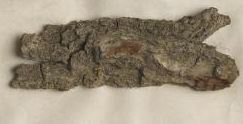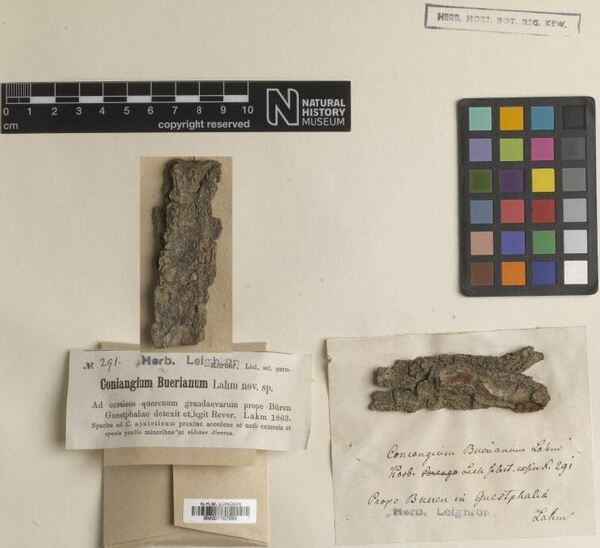Arthonia bueriana (J. Lahm) Zahlbr.
Cat. Lich. Univ., 2: 14, 1922. Basionym: Coniangium buerianum J. Lahm - Verh. zool.-bot. Ges. Wien, 23: 507, 1874.
Synonyms: Arthonia convexella Nyl.
Distribution: N - Lomb (Morisi & Sereno 1995).
Description: Thallus crustose, mostly endosubstratic and inconspicuous, pale brown or olive-grey, doubtfully lichenized. Apothecia arthonioid, more or less immersed, rounded to slightly and irregularly lobed, 0.1-0.3 mm wide, with a black, epruinose, convex disc, without a proper margin. Proper exciple absent; epithecium brown-black, K-; hymenium colourless 45-55 μm high, I+ red; paraphysoids 0.5-1.5 μm thick at base; hypothecium brown, 25-35 μm high, K+ olive-green. Asci 8-spored, subglobose, semi-fissitunicate, with a large apical dome and a distinct ocular chamber, Arthonia-type. Ascospores 1-septate and slightly constricted at septum, with slightly unequal cells, hyaline, ellipsoid, 12-15 x 4-5 μm. Photobiont absent or trentepohlioid. Spot tests: K-, C-, KC-, P-. Chemistry: thallus without lichen substances. Note: a rare, perhaps non-lichenised corticolous species known from a few stations in the submediterranean and montane belts of the Alps and in central Europe.
Growth form: Fungus
Substrata: bark
Reproductive strategy: mainly sexual
Pioneer species
Commonnes-rarity: (info)
Alpine belt: absent
Subalpine belt: absent
Oromediterranean belt: absent
Montane belt: extremely rare
Submediterranean belt: extremely rare
Padanian area: absent
Humid submediterranean belt: absent
Humid mediterranean belt: absent
Dry mediterranean belt: absent

Predictive model
Growth form: Fungus
Substrata: bark
Reproductive strategy: mainly sexual
Pioneer species
Commonnes-rarity: (info)
Alpine belt: absent
Subalpine belt: absent
Oromediterranean belt: absent
Montane belt: extremely rare
Submediterranean belt: extremely rare
Padanian area: absent
Humid submediterranean belt: absent
Humid mediterranean belt: absent
Dry mediterranean belt: absent

Predictive model
 Index Fungorum
Index Fungorum
 GBIF
GBIF



